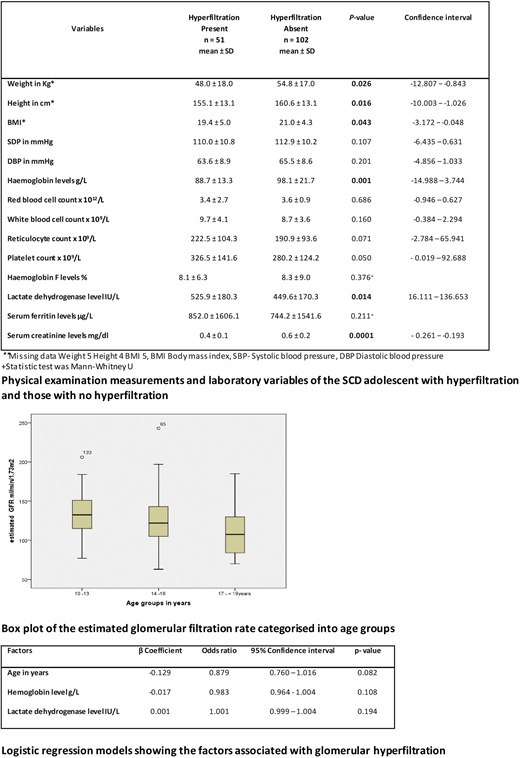Background:Renal abnormalities in sickle cell disease commence early in childhood. Glomerular hyperfiltration and albuminuria are the most prevalent renal abnormalities in sickle cell disease. However, these renal abnormalities of SCD have not been considered exclusively in the adolescent age group.
Objective:To determine the prevalence of glomerular hyperfiltration and albuminuria as well as identify the determinants for glomerular hyperfiltration in adolescents with SCD.
Patients and Methods:Ethical permission was through the Trust audit and service evaluation governance review board to implement quality assessment of clinical service. Electronic patient records (charts) of 153 adolescents with SCD aged 10->19 years, attending the Paediatrics Haematology Clinic at Evelina children Hospital, London, United Kingdom. Clinical information obtained included demographics age, gender sickle cell type, as well as history of acute event, treatment history, anthropometric indices and blood pressure. The laboratory parameters obtained were urine albumin-creatinine ratio or protein-creatinine ratio, haemoglobin level, white blood cell count, red blood cell count, platelet count, reticulocyte count, foetal haemoglobin level, lactate dehydrogenase level, serum creatinine and serum ferritin level. The glomerular filtration rate was derived using the Bedside Schwartz's method. Grouping of the adolescents was based on present and absence of glomerular hyperfiltration, which was defined as glomerular filtration rate > 140ml/min/m2. The presence of albuminuria was defined as urine albumin-to-creatinine ratio >3mg/mmol or protein- to- creatinine ratio of > 15mg/mmol. Investigated were the clinical and laboratory determinants of glomerular hyperfiltration in the total study population.
Result:Prevalence of glomerular hyperfiltration was 33.3% in the adolescents studied (age bracket please) , and that of albuminuria was 15.7% amongst the adolescents with SCD studies (microalbuminuria 14.4%, and 1.3% overt proteinuria) of which 13.7% of those with glomerular hyperfiltration also had albuminuria. The mean eGFR of the adolescents with SCD who had glomerular hyperfiltration was 160.2 ± 20.0 ml/min/1.73m2, and that of those with no glomerular hyperfiltration was 109.9 ± 19.3ml/min/m2. A significantly higher proportion of the adolescents with SCD who had glomerular hyperfiltration had the haemoglobin SS disease (47 (92.2%) versus 68 (66.7%);P=0.007). On univariable analysis, the adolescent with glomerular hyperfiltration had significantly lower weight (48.0 ± 18.0 versus 54.8 ± 17.0 kg;p= 0.02), height (155.1 ± 13.1 versus 160.6 ± 13.1 cm;p= 0.01), body mass index (19.4 ± 5.0 versus 21.0 ± 4.3 ;p= 0.04), haemoglobin level (88.7 ± 13.3 versus 98.1 ± 21.7 g/L;p= 0.001), and serum creatinine level (0.4 ± 0.1 versus 0.6 ± 0.2mg/dl;p= 0.0001) as compared to those with no glomerular hyperfiltration. The adolescents with glomerular hyperfiltration also had significantly higher lactate dehydrogenase level (525.9 ± 180.3 versus 449.6 ± 170.3 IU/L;p= 0.01) as compared to those with no glomerular hyperfiltration. However, no association was found on multivariable analysis.
Conclusion:This study revealed that the prevalence of glomerular hyperfiltration in the adolescent age group was high, and the high glomerular filtration rates begin to decline toward normal values in middle adolescent age not before.
Inusa:AstraZeneca:Honoraria, Other: Steering committee participation, Research Funding, Speakers Bureau;Vertex:Research Funding;Global Blood Therapeutics:Honoraria, Other: Steering committee participation, Research Funding, Speakers Bureau;Bluebird bio:Research Funding;Novartis:Honoraria, Other: Steering committee participation, Research Funding, Speakers Bureau.
Author notes
Asterisk with author names denotes non-ASH members.


This feature is available to Subscribers Only
Sign In or Create an Account Close Modal